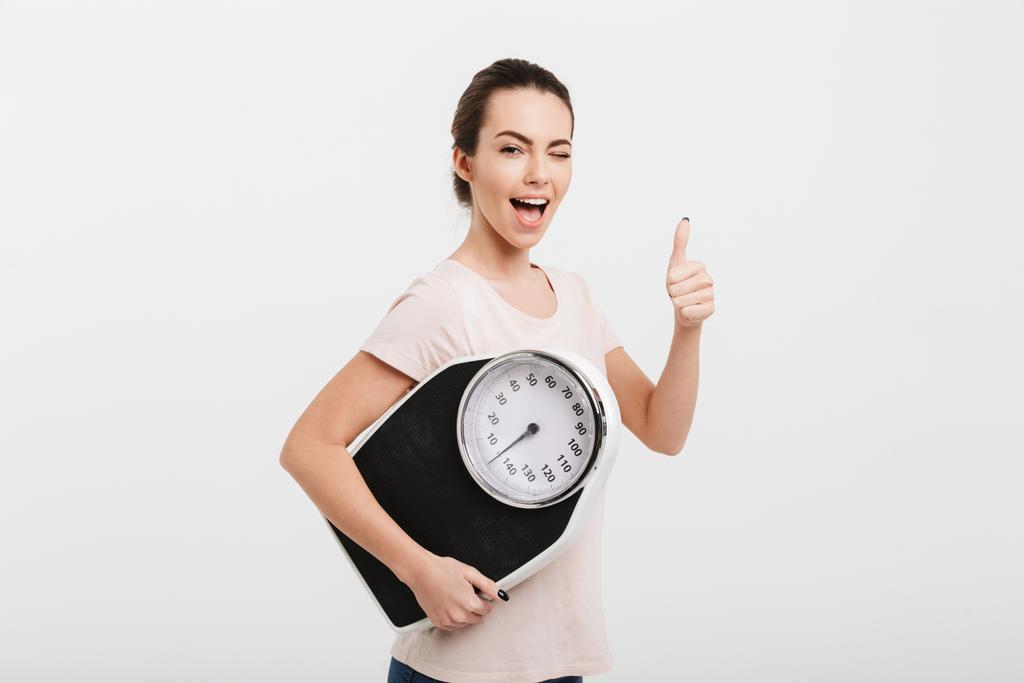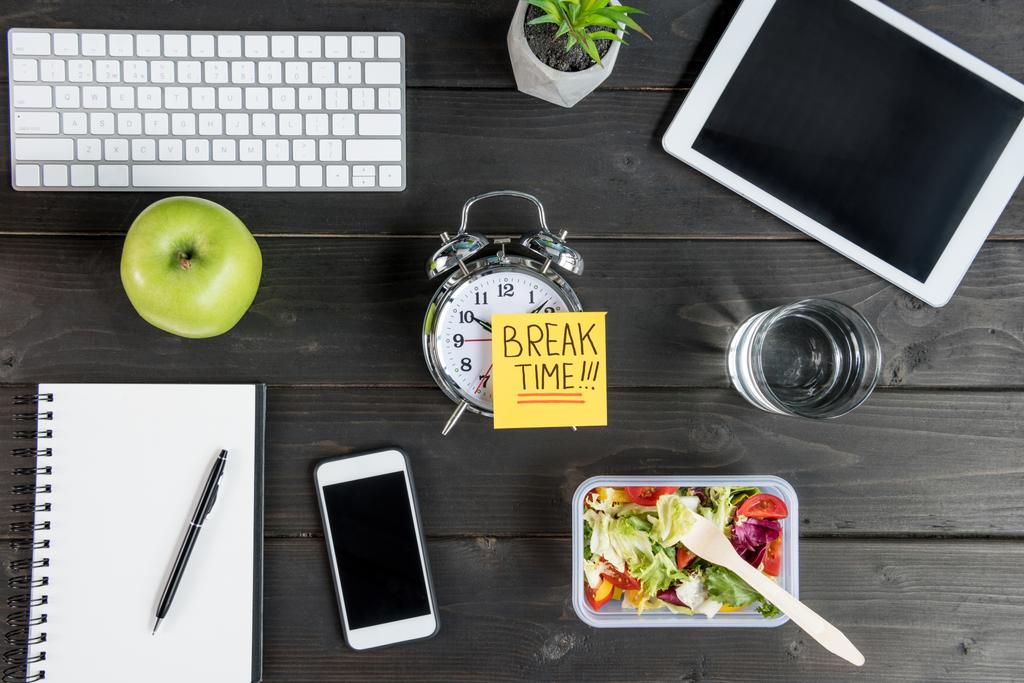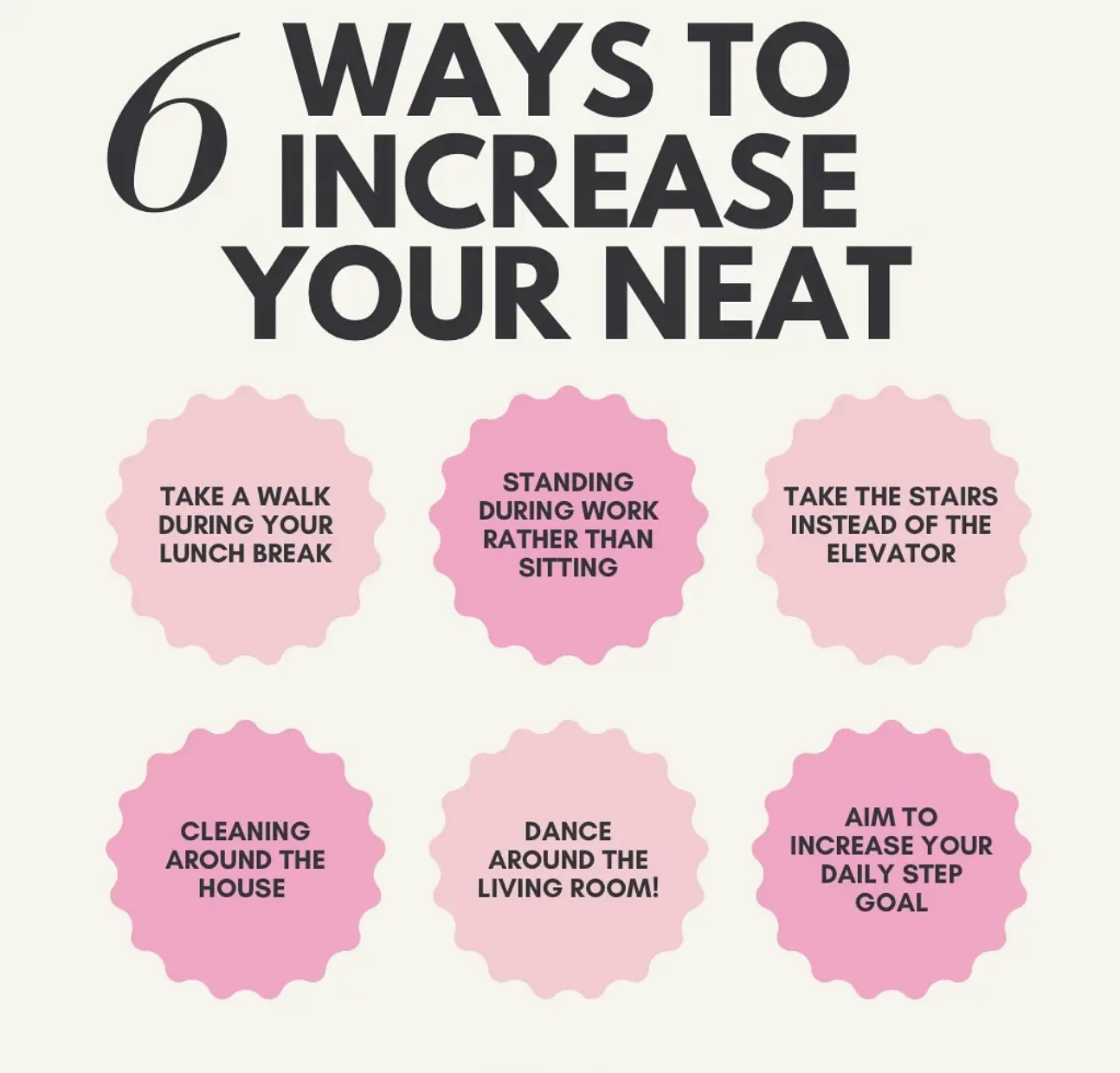Understanding NEAT and Its Impact on Weight Loss
In our quest for better health and sustainable weight management, we often focus on diet plans and exercise routines. However, there’s a powerful yet often overlooked factor that can significantly impact our weight loss journey: NEAT, or Non-Exercise Activity Thermogenesis. In this comprehensive guide, we’ll explore 6 ways to increase your NEAT and unlock the potential for effortless weight loss and improved health.
What is NEAT?

NEAT, short for Non-Exercise Activity Thermogenesis, refers to the energy our bodies expend during everyday activities that aren’t formal exercise. This includes everything from fidgeting and standing to walking to your car and doing household chores. Essentially, NEAT encompasses all the calories you burn when you’re not sleeping, eating, or engaging in purposeful exercise.
As someone who’s always been interested in health and fitness, I was fascinated to learn about NEAT and its significant impact on our metabolism. It’s a concept that can revolutionize how we approach weight management and overall well-being. When we think about increasing our NEAT, we’re essentially looking at ways to become more active in our daily lives, outside of structured workout sessions.
The Explore Behind NEAT and Weight Management
To understand why NEAT is so crucial for weight management, we need to delve into the science behind it. Our bodies are constantly burning calories, even when we’re at rest. However, the number of calories burned through NEAT can vary dramatically from person to person and can have a substantial impact on overall energy expenditure.

Research has shown that NEAT can account for anywhere from 15% to 50% of our total daily energy expenditure. This wide range illustrates the potential impact of increasing your NEAT on weight management. For example, a study published in the journal “Science” found that lean individuals tend to engage in significantly more NEAT activities than their obese counterparts, even when both groups have sedentary jobs.
Comparison of Daily Energy Expenditure Components
As we can see from this table, NEAT has the potential to be a significant factor in our daily calorie burn. By focusing on ways to increase your NEAT, you can potentially boost your metabolism and create a calorie deficit without relying solely on traditional diet and exercise methods.
The variability in NEAT between individuals is particularly interesting. Studies have shown that even when people are overfed by the same amount, some naturally increase their NEAT to compensate, while others don’t. This suggests that NEAT could be a key factor in why some people seem to maintain their weight effortlessly while others struggle.
Why Focusing on NEAT Its Potential Impact

Now that we understand what NEAT is and its potential impact on our metabolism, let’s explore why focusing on increasing your NEAT can be a game-changer for weight loss and overall health.
- Sustainability: Unlike strict diets or intense workout regimens, increasing your NEAT involves making small, manageable changes to your daily routine. This makes it much easier to sustain over the long term. We’ve all experienced the burnout that can come from trying to maintain an intense exercise schedule or a restrictive diet. By contrast, increasing your NEAT feels more natural and less like a chore.
- Accessibility: NEAT activities are accessible to almost everyone, regardless of age, fitness level, or physical limitations. You don’t need a gym membership or special equipment to start benefiting from increased NEAT. This makes it an ideal strategy for those who may find traditional exercise challenging or intimidating.
- Cumulative Effect: Small increases in daily movement can add up to significant calorie burn over time. By consistently finding ways to increase your NEAT, you can create a substantial impact on your metabolism and weight management efforts. For example, standing instead of sitting for an extra hour each day could burn an additional 50-100 calories. While this might not seem like much, over a year, it could add up to 5-10 pounds of weight loss!
- Improved Overall Health: Increasing your NEAT not only helps with weight management but also contributes to better cardiovascular health, improved insulin sensitivity, and reduced risk of chronic diseases associated with sedentary behavior. Studies have shown that even small increases in daily activity can have significant health benefits.
- Mental Health Benefits: Many NEAT-boosting activities, such as taking a walk during your lunch break or gardening, can also have positive effects on your mental health and stress levels. These activities can provide a much-needed break from the demands of work or other responsibilities, helping to reduce stress and improve overall well-being.
As we explore 6 ways to increase your NEAT throughout this article, keep in mind that the goal is to make these changes sustainable and enjoyable. By integrating more movement into your daily life, you’ll not only be working towards your weight loss goals but also improving your overall quality of life.
The Benefits of Increasing Your NEAT

Now that we’ve established what NEAT is and why it’s important, let’s more deeper into the specific benefits of increasing your NEAT. Understanding these benefits can provide powerful motivation as you work to incorporate more movement into your daily life.
Boosting Metabolism Without Traditional Exercise
One of the most significant benefits of increasing your NEAT is that it allows you to boost your metabolism without relying on traditional exercise. While structured workouts are certainly beneficial, they’re not the only way to increase your calorie burn.
By focusing on ways to increase your NEAT, you’re essentially turning your entire day into an opportunity for calorie burning. This can be particularly beneficial for those who:
- Have busy schedules that make it difficult to fit in regular gym sessions
- Dislike traditional forms of exercise
- Have physical limitations that make intense workouts challenging
- Are looking for ways to complement their existing exercise routine
For example, a study published in the “American Journal of Clinical Nutrition” found that lean individuals burned an average of 350 more calories per day through NEAT activities compared to obese individuals. This difference in NEAT could account for up to 36 pounds of weight gain or loss over the course of a year!
Sustainable Weight Loss Through Daily Activities
One of the key advantages of focusing on NEAT for weight loss is its sustainability. Many weight loss strategies fail because they’re too drastic or difficult to maintain long-term. Increasing your NEAT, on the other hand, involves making small, manageable changes to your daily routine.
These changes, while seemingly minor, can add up to significant calorie burn over time. For instance:
- Taking the stairs instead of the elevator could burn an extra 5-10 calories per minute
- Standing while working for an hour could burn an additional 50 calories
- Pacing while on the phone for 30 minutes could burn around 35-40 calories
While these numbers might seem small, remember that NEAT is about the cumulative effect of these activities over time. If you consistently choose the more active option throughout your day, you could potentially burn hundreds of extra calories without ever setting foot in a gym.
Moreover, because these changes are integrated into your daily life, they’re more likely to become habitual. This means you’re more likely to stick with them long-term, leading to sustainable weight loss and management.
Improved Overall Health and Well-being
Increasing your NEAT doesn’t just benefit your waistline – it can have a profound impact on your overall health and well-being. Here are some of the additional health benefits you might experience:
- Improved Cardiovascular Health: Even light physical activity can improve heart health. A study published in the “British Journal of Sports Medicine” found that replacing just 30 minutes of sitting with light activity each day was associated with a 14% reduced risk of cardiovascular disease.
- Better Blood Sugar Control: Regular movement throughout the day can help regulate blood sugar levels. This is particularly important for individuals with or at risk of type 2 diabetes.
- Reduced Risk of Chronic Diseases: Increased daily activity has been linked to a lower risk of various chronic diseases, including certain cancers, osteoporosis, and cardiovascular disease.
- Improved Mental Health: Physical activity, even at low intensities, has been shown to have positive effects on mood and mental health. It can help reduce symptoms of anxiety and depression and improve overall cognitive function.
- Better Posture and Reduced Back Pain: Many NEAT-boosting activities, such as standing and walking, can help improve posture and reduce the risk of back pain associated with prolonged sitting.
- Enhanced Energy Levels: While it might seem counterintuitive, increasing your activity levels can actually boost your energy. Many people report feeling more energized and alert when they incorporate more movement into their day.
By focusing on ways to increase your NEAT, you’re not just working towards weight loss, you’re investing in your overall health and quality of life.
6 Ways To Increase Your NEAT: Practical Strategies for Daily Life
Now that we understand the importance and benefits of NEAT, let’s explore six practical strategies to increase your NEAT in daily life. Remember, the goal is to make these changes sustainable and enjoyable, so feel free to adapt these suggestions to fit your lifestyle and preferences.
Stand More, Sit Less
One of the simplest yet most effective ways to increase your NEAT is to reduce the amount of time you spend sitting. In our modern, sedentary society, many of us spend the majority of our waking hours seated – at work, during our commute, and while relaxing at home. By making a conscious effort to stand more, we can significantly increase our daily calorie burn.
Here are some practical ways to implement this strategy:
- Use a Standing Desk: If possible, invest in a standing desk or a desk converter that allows you to alternate between sitting and standing throughout your workday. Start with short periods of standing and gradually increase as you build stamina.
- Take Standing Breaks: If a standing desk isn’t an option, set a timer to remind yourself to stand up and stretch every hour. Even a few minutes of standing can make a difference.
- Stand During Phone Calls: Make it a habit to stand up and pace whenever you’re on the phone. This is an easy way to add movement to your day without disrupting your work.
- Create a Standing Station: Set up a high counter or table at home where you can stand to do activities like reading, checking emails, or even watching TV.
- Stand on Public Transport: If you use public transportation, try standing instead of sitting during your commute.
Remember, the goal isn’t to stand all day – that can lead to its own set of problems. Instead, aim for a healthy balance between sitting and standing throughout your day.
Take the Stairs and Walk Whenever Possible

Walking is one of the most accessible forms of physical activity, and incorporating more steps into your day is a great way to increase your NEAT. Here are some ways to walk more:
- Take the Stairs: Whenever you have the option between stairs and an elevator or escalator, choose the stairs. Even if you’re going to a high floor, consider taking the stairs for part of the way.
- Park Further Away: When driving to work or running errands, park your car further away from your destination. Those extra steps add up over time.
- Walking Meetings: Suggest walking meetings instead of sitting in a conference room. This can be especially effective for one-on-one meetings or brainstorming sessions.
- Lunchtime Walks: Use part of your lunch break to take a short walk. This not only increases your NEAT but can also help refresh your mind for the afternoon.
- Walk and Talk: When catching up with friends or family on the phone, do it while walking around your home or neighborhood.
- Public Transport Strategy: If you use public transportation, consider getting off a stop early and walking the rest of the way.
By consistently choosing to walk more, you can significantly increase your daily step count and, consequently, your NEAT.
Incorporate Movement into Work and Leisure Time
Finding ways to add movement to your work and leisure activities can be a fun and effective way to increase your NEAT. Here are some ideas:
- Active Workstation: Consider using a treadmill desk or under-desk bike to keep moving while you work.
- Fidget More: Small movements like tapping your feet, stretching, or using a stress ball can increase your NEAT.
- Active TV Watching: Instead of sitting on the couch while watching TV, try doing light exercises, stretching, or using an exercise ball as a seat.
- Gaming with Movement: If you enjoy video games, try games that require physical movement, like those on Nintendo Wii or VR systems.
- Stand-up Comedy: When watching comedy shows or movies, make it a rule to stand up every time you laugh.
- Housework as Exercise: Approach household chores as an opportunity for movement. Put extra energy into vacuuming, gardening, or cleaning windows.
The key is to find ways to add movement that you enjoy and can sustain over time.
Boost Household Activity
Household chores and DIY projects can be excellent opportunities to increase your NEAT. Not only will you burn more calories, but you’ll also have a cleaner, more organized living space. Here are some ways to boost your household activity:
- Manual Labor: Choose manual options over electric ones when possible. For example, use a push mower instead of a riding mower, or wash dishes by hand occasionally instead of always using the dishwasher.
- Cleaning Marathons: Instead of spreading out your cleaning tasks throughout the week, consider dedicating a chunk of time to do a thorough clean of your entire home. This sustained activity can significantly boost your NEAT.
- Gardening: If you have outdoor space, gardening can be an excellent way to increase your NEAT. Digging, planting, weeding, and watering all contribute to your daily activity.
- Home Improvement Projects: Take on DIY projects around your home. Painting a room, building furniture, or doing minor repairs can all increase your NEAT.
- Cook More: Preparing meals from scratch involves more movement than ordering takeout or heating up pre-made meals. Plus, home-cooked meals are often healthier.
- Rearrange Frequently: Periodically rearranging your furniture or reorganizing closets and drawers can provide a good bout of physical activity.
By viewing household tasks as opportunities for movement rather than chores, you can make your home life more active and increase your NEAT.
Make Social Activities More Active

Social interactions don’t have to revolve around sedentary activities like sitting in cafes or restaurants. By suggesting more active options, you can increase your NEAT while enjoying time with friends and family. Here are some ideas:
- Walking Dates: Instead of meeting friends for coffee, suggest a walk in a local park or around a shopping district.
- Active Hobbies: Take up active hobbies that you can do with others, such as dancing, hiking, or recreational sports.
- Volunteer for Physical Tasks: Look for volunteer opportunities that involve physical activity, such as community clean-ups or building projects.
- Active Tourism: When traveling or exploring your local area, opt for walking tours or bike rentals instead of bus tours.
- Family Fun: Organize active family outings like trips to the zoo, amusement parks, or nature reserves where you’ll do a lot of walking.
- Social Sports: Join a casual sports league or organize regular games with friends. Even low-intensity sports like bowling or golf can increase your NEAT.
By making your social life more active, you’ll not only increase your NEAT but also create more memorable experiences with your loved ones.
Explore Technology for NEAT
While technology is often blamed for our sedentary lifestyles, it can also be a powerful tool for increasing your NEAT. Here’s how you can use technology to your advantage:
- Fitness Trackers: Use a pedometer or fitness tracker to monitor your daily steps and activity levels. Many of these devices also provide reminders to move regularly.
- Active Video Games: Choose video games that require physical movement, such as dance games or virtual reality fitness programs.
- Standing Reminders: Use apps that remind you to stand up and move around at regular intervals throughout the day.
- Online Workout Videos: Follow along with short, low-intensity workout videos that you can do at home or in the office to break up long periods of sitting.
- Smart Home Devices: Use smart home devices to your advantage. For example, place your smart speaker in another room so you have to get up to adjust it.
- Active Commute Apps: Use apps that encourage active commuting, such as those that provide walking or cycling routes.
By leveraging technology, you can make increasing your NEAT more engaging and easier to track.
Measuring and Tracking Your NEAT
To effectively increase your NEAT, it’s helpful to have a way to measure and track your progress. This section will explore various tools and methods for monitoring your daily activity and setting realistic NEAT goals.
Tools and Apps to Monitor Daily Activity
There are numerous tools available to help you track your NEAT. Here are some popular options:
- Pedometers: These simple devices count your steps throughout the day. While basic, they can be an effective way to monitor your walking activity.
- Fitness Trackers: Devices like Fitbit, Apple Watch, or Garmin watches offer more comprehensive tracking. They can monitor steps, active minutes, heart rate, and even distinguish between different types of activities.
- Smartphone Apps: Many smartphones have built-in health apps that can track steps and activity levels. There are also numerous third-party apps available for both iOS and Android that can help you monitor your NEAT.
- Smart Scales: Some smart scales can estimate your basal metabolic rate, which can be useful in calculating how many additional calories you’re burning through NEAT.
- NEAT Calculators: While not as precise as wearable devices, online NEAT calculators can give you a rough estimate of your NEAT based on your daily activities.
When choosing a tracking method, consider factors like ease of use, accuracy, and the type of data you’re most interested in. Remember, the best tracking tool is one that you’ll use consistently.
Setting Realistic NEAT Goals
Once you have a way to measure your NEAT, it’s important to set realistic goals. Here’s how you can approach this:
- Establish a Baseline: Start by tracking your current activity levels for a week or two. This will give you a baseline to improve upon.
- Set Incremental Goals: Rather than aiming for a drastic increase in activity, set small, achievable goals. For example, if you currently average 5,000 steps a day, aim to increase that to 6,000 steps daily for the next week.
- Focus on Consistency: It’s better to make small increases that you can maintain consistently than to have large spikes of activity followed by periods of inactivity.
- Adjust Goals Based on Progress: As you achieve your initial goals, gradually increase them. This could mean adding more steps, more active minutes, or incorporating new NEAT activities.
- Consider Your Lifestyle: Set goals that fit with your daily routine and responsibilities. If you have a desk job, your NEAT goals might focus more on standing breaks and lunchtime walks, while someone with a more active job might focus on increasing activity during leisure time.
- Track Non-Step Activities: While step count is a common NEAT metric, don’t forget to set goals for other activities like standing time or household chores.
Remember, the aim is to gradually increase your overall daily activity level in a way that’s sustainable for you.
Overcoming Challenges to Increasing NEAT
While increasing your NEAT can be an effective strategy for weight management and overall health, it’s not without its challenges. In this section, we’ll address some common obstacles and provide strategies to overcome them.
Time Constraints and Busy Schedules
One of the most common barriers to increasing NEAT is a lack of time. Many of us lead busy lives, juggling work, family responsibilities, and other commitments. Here are some strategies to increase your NEAT even with a packed schedule:
- Integrate Movement into Existing Activities: Look for ways to add movement to things you’re already doing. For example, pace while on phone calls or do calf raises while brushing your teeth.
- Prioritize Active Commuting: If possible, walk or bike for part or all of your commute. If you use public transport, stand instead of sitting or get off a stop early and walk the rest of the way.
- Use Breaks Wisely: Even short breaks can be opportunities for movement. A 5-minute walk during your lunch break or between meetings can add up over time.
- Multitask with Movement: When watching TV or listening to podcasts, try to be active at the same time. You could march in place, do light stretching, or even tackle some household chores.
- Schedule Movement: Just as you would schedule important meetings, block out time in your calendar for active breaks or longer periods of movement.
Increasing your NEAT doesn’t always require large chunks of time. Small pockets of activity throughout the day can make a significant difference.
Sedentary Work Environments
Many of us work in environments that encourage sedentary behavior. If you have a desk job, here are some strategies to increase your NEAT:
- Use a Standing or Treadmill Desk: If your workplace allows it, consider using a standing desk or a treadmill desk for part of your day.
- Take Regular Standing Breaks: Set a timer to remind you to stand up and move around every hour, even if it’s just for a minute or two.
- Walking Meetings: Suggest walking meetings for one-on-one discussions or brainstorming sessions.
- Use a Smaller Water Bottle: This will require you to get up and refill it more often, adding more movement to your day.
- Chair Exercises: Even while seated, you can do small movements like leg raises, ankle rotations, or seated marches to increase your NEAT.
- Active Lunch Breaks: Use part of your lunch break to take a walk, even if it’s just around your office building.
Remember to communicate with your employer about your desire to be more active during the workday. Many companies are becoming more aware of the health benefits of an active workforce and may be supportive of your efforts.
Motivation and Habit Formation
Staying motivated to increase your NEAT and forming new, more active habits can be challenging. Here are some strategies to help:
- Start Small: Begin with small, achievable changes. Success with these can boost your motivation to take on bigger changes.
- Track Your Progress: Use a fitness tracker or app to monitor your activity levels. Seeing your progress can be a powerful motivator.
- Set Specific Goals: Instead of a vague goal like “move more,” set specific targets like “take a 10-minute walk after lunch every day” or “use the stairs instead of the elevator at least once a day.”
- Find an Accountability Partner: Share your goals with a friend, family member, or colleague who can encourage you and check in on your progress.
- Reward Yourself: Set up a reward system for achieving your NEAT goals. This could be something small like a favorite healthy snack or a bigger reward for long-term consistency.
- Make it Enjoyable: Find ways to make increased movement fun. This could involve listening to music or podcasts while walking, or turning household chores into a game.
- Be Patient: Remember that habit formation takes time. It’s often said that it takes about 21 days to form a new habit, but research suggests it can take anywhere from 18 to 254 days. Be patient with yourself and celebrate small victories along the way.
By addressing these common challenges head-on, you can overcome obstacles to increasing your NEAT and make lasting changes to your daily activity levels.
NEAT vs. Traditional Exercise: Finding the Right Balance

While increasing your NEAT can have significant benefits for weight management and overall health, it’s important to understand how it fits in with traditional exercise. In this section, we’ll explore the relationship between NEAT and structured exercise, and how to find the right balance for optimal health.
Complementing Your Workout Routine with NEAT
NEAT and traditional exercise are not mutually exclusive – in fact, they work best when used together. Here’s how NEAT can complement your existing workout routine:
- Increased Overall Calorie Burn: While a 30-minute workout is beneficial, increasing your NEAT can help you burn calories throughout the entire day.
- Active Recovery: On rest days or between intense workouts, NEAT activities can provide gentle movement that aids in recovery without overtaxing your body.
- Improved Cardiovascular Health: Regular movement throughout the day, in addition to structured cardio workouts, can contribute to better heart health.
- Enhanced Flexibility and Mobility: Many NEAT activities involve a range of motions that can help maintain flexibility, complementing your stretching or yoga practice.
- Stress Management: Both NEAT and exercise can help manage stress, but the low-intensity nature of NEAT activities can be particularly soothing.
- Habit Formation: Increasing your NEAT can help build an overall more active lifestyle, which can make it easier to stick to your structured exercise routine.
The goal is not to replace your workouts with NEAT, but to use them in tandem for optimal health benefits.
NEAT for Those Who Dislike Formal Exercise
For individuals who struggle with or dislike traditional exercise, focusing on NEAT can be a game-changer. Here’s why:
- Lower Barrier to Entry: NEAT activities are often easier to start and maintain than structured exercise programs.
- Less Intimidating: For those who feel uncomfortable in gym settings or with formal exercise, NEAT offers a way to increase activity without these pressures.
- Customizable: NEAT can be tailored to fit any lifestyle or physical ability level.
- Gradual Progress: Increasing NEAT allows for a more gradual approach to becoming more active, which can be less overwhelming than jumping into an intense exercise routine.
- Immediate Benefits: Many people report feeling more energized and productive when they increase their NEAT, which can provide immediate positive reinforcement.
- Sustainable Long-term: Because NEAT involves changing daily habits rather than adding a new routine, it can be easier to maintain over the long term.
While increasing NEAT can be highly beneficial, it’s important to note that for optimal health, some form of structured exercise is still recommended. However, starting with NEAT can be an excellent way to build up to more formal exercise routines.
Success Stories: Real People Who Transformed Their Lives with NEAT
To illustrate the potential impact of increasing NEAT, let’s look at some real-life success stories. These individuals have made significant changes to their health and well-being by focusing on increasing their daily activity levels.
Real Case Study 1: Sarah’s Office Transformation
Sarah, a 35-year-old office worker, had struggled with her weight for years. Despite trying various diets and exercise programs, she found it difficult to maintain any progress. After learning about NEAT, she decided to make some changes to her daily routine:
- She started using a standing desk for half of her workday
- She began taking short walking breaks every hour
- She opted for walking meetings when possible
- She started parking further away from her office
After six months, Sarah had lost 15 pounds without making any other significant changes to her diet or adding a formal exercise routine. She reported feeling more energetic throughout the day and noticed improvements in her posture and reduced back pain.
Real Case Study 2: Tom’s Active Retirement
Tom, a 68-year-old retiree, was concerned about maintaining his health and mobility as he aged. He wasn’t interested in joining a gym but wanted to stay active. He focused on increasing his NEAT in the following ways:
- He started gardening more frequently
- He began walking his dog three times a day instead of two
- He took up ballroom dancing with his wife once a week
- He started doing more DIY projects around the house
After a year, Tom reported feeling stronger and more flexible. His doctor noted improvements in his cardiovascular health and bone density. Tom’s wife also commented that he seemed more upbeat and energetic.
Case Study 3: Maria’s Family NEAT Challenge
Maria, a 42-year-old mother of two, wanted to set a good example for her children and improve the whole family’s health. She created a family NEAT challenge:
- They started having weekly active family outings (hiking, swimming, etc.)
- They implemented a “commercial break challenge” during TV time, where everyone had to get up and move during commercials
- They started walking to school instead of driving
- They began doing active video gaming sessions as a family
After three months, the whole family reported feeling closer and more energetic. Maria lost 10 pounds, and her children showed improved focus at school. The family decided to make their NEAT challenge a permanent lifestyle change.
These success stories demonstrate that increasing NEAT can lead to significant improvements in health and well-being, often in ways that feel more sustainable than traditional diet and exercise programs.
The Future of NEAT: Emerging Research and Trends

As our understanding of NEAT and its impact on health continues to grow, researchers are exploring new areas and developing innovative approaches to increasing daily activity levels. Here are some emerging trends and areas of research in the field of NEAT:
- Workplace Design: There’s growing interest in how office layouts and furniture can promote movement. Future workplaces may be designed with NEAT in mind, incorporating features like treadmill desks, standing meeting areas, and indoor walking tracks.
- Wearable Technology: As wearable devices become more sophisticated, they may offer more precise NEAT measurements and personalized recommendations for increasing daily activity.
- NEAT and Mental Health: Researchers are exploring the potential mental health benefits of increased NEAT, including its effects on mood, cognitive function, and stress levels.
- NEAT in Disease Prevention: Studies are investigating how NEAT might play a role in preventing or managing chronic diseases like diabetes, heart disease, and certain cancers.
- Gamification of NEAT: There’s growing interest in using game-like elements to encourage increased daily activity, from smartphone apps to augmented reality experiences.
- NEAT and Aging: Researchers are studying how NEAT can be used to maintain mobility and independence in older adults.
- Personalized NEAT Prescriptions: Future healthcare providers may prescribe specific NEAT activities based on an individual’s health status, lifestyle, and goals.
- Environmental Design for NEAT: Urban planners and architects are considering how to design buildings and public spaces that naturally encourage more movement.
- NEAT and Productivity: Studies are exploring the relationship between increased NEAT and workplace productivity, potentially leading to more employer-supported NEAT initiatives.
As research in these areas progresses, we can expect to see more innovative strategies and tools for increasing NEAT, making it easier for individuals to incorporate more movement into their daily lives.
Explore a NEAT-centric Lifestyle for Long-term Health
As we’ve explored throughout this article, increasing your NEAT can be a powerful strategy for weight management, improved health, and enhanced well-being. Unlike traditional exercise programs or strict diets, focusing on NEAT allows for a more holistic and sustainable approach to health.
By implementing the 6 ways to increase your NEAT that we’ve discussed – standing more, walking whenever possible, incorporating movement into work and leisure time, boosting household activity, making social activities more active, and embracing technology – you can significantly increase your daily calorie burn without drastically altering your lifestyle.As you embark on your journey to increase your NEAT, keep these final thoughts in mind:
- Personalize Your Approach: What works for one person may not work for another. Experiment with different strategies and find what fits best with your lifestyle and preferences.
- Be Mindful of Your Movement: Try to become more aware of your activity levels throughout the day. This mindfulness can help you identify opportunities for increased movement.
- Celebrate Small Wins: Recognize and celebrate the small increases in your daily activity. These little victories can help maintain your motivation.
- Stay Flexible: Life can be unpredictable. If you have a particularly sedentary day, don’t be discouraged. Just aim to be more active the next day.
- Share Your Journey: Consider sharing your NEAT-increasing efforts with friends and family. You might inspire others to join you, creating a supportive community.
- Keep Learning: Stay informed about new research and strategies related to NEAT. As our understanding of the importance of daily movement grows, new and exciting ways to increase NEAT may emerge.
By explore a NEAT-centric lifestyle, you’re not just working towards better health – you’re redefining your relationship with physical activity. You’re transforming everyday moments into opportunities for movement, turning your entire day into a chance to improve your health and well-being.


















